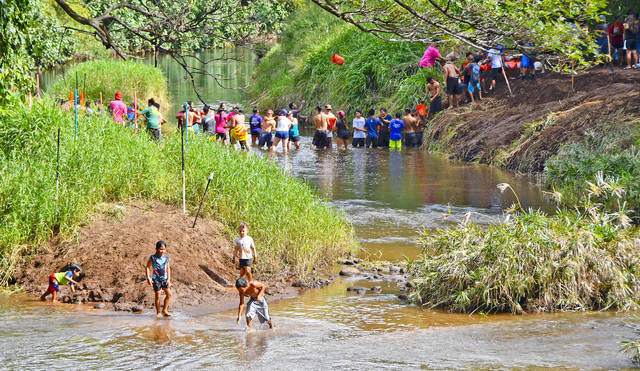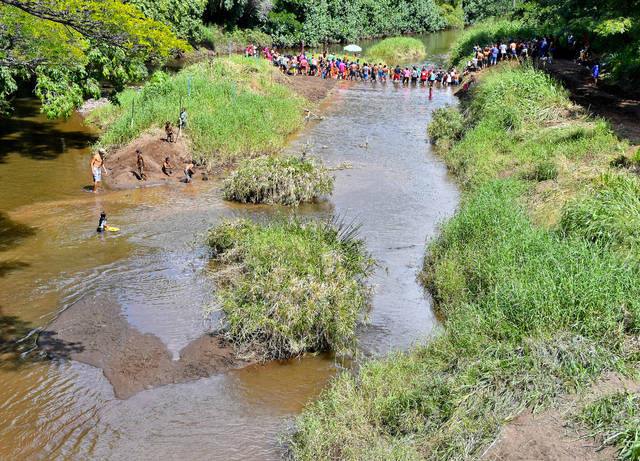WAIMEA — The scene was reminiscent of days of yesteryear as keiki frolicked in the waters of the Waimea River while older people, many of them students, toiled in the broiling Waimea sunshine Sunday. “Now I know how the Egyptians
WAIMEA — The scene was reminiscent of days of yesteryear as keiki frolicked in the waters of the Waimea River while older people, many of them students, toiled in the broiling Waimea sunshine Sunday.
“Now I know how the Egyptians felt like,” said one student in the bucket brigade, hefting his load to the next pair of hands.
More than a hundred people turned out for the second of two work days planned by Waimea High School and Kumano i ke ala o Makaweli for the purpose of removing silt accumulation and the resulting islands from the base of the Waimea River. More than 200 showed up Saturday.
“It’s so nice to see so many people working — especially the young students,” said Carla Dusenberry, whose father’s house is nearby. “This is healthy for them — they’re not buried in their phones, or hiding behind laptop computers.”
Waimea High School teachers Berna Souza and Shelby Erdmann combined their freshman and senior English classes under a Mauka-2-Makai project- based learning group that has been studying the health of the Waimea River.
“Our goal for this first community workday was to remove at least 20,000 buckets of silt per day,” Souza said. “I don’t think we did that, but our next goal was to at least cut through one of the islands.”
Souza said more than 200 people, including community groups such as the Namahoe crew and area Boy Scouts, and officials such as Kauai Area Complex Superintendent Bill Arakaki and Mayor Bernard Carvalho Jr., turned out Saturday to help the students haul buckets of silt.
“We had people from all parts of the island,” Souza said. “The mayor even went in the water, and it was a good thing he played football — he could lift those buckets up the bank.”
On Saturday, “We had enough people to form four lines,” Souza said. “Today, we’re hoping more people come after church.”
The students’ efforts were combined with Kaina Makua, a kalo farmer in Makaweli Valley and director of the nonprofit organization Kumano i ke Ala, whose mission is centered on increasing farmers in the valley through aina-based education.
The groups say that water diversion systems, put in place during the plantation era, continue to remove more than 18 million gallons of water a day from the river’s mountain source. This has caused an inconsistent river flow that has resulted in a number of large silt islands to form before the river mouth.
This silt accumulation harms the ecosystem and creates a flood hazard after heavy rains and river flows.
Cory Goias-Soares was one of the volunteers, despite his wrist being heavily wrapped in a bandage.
“I can’t do the buckets,” Goias-Soares said. “But I keep time and let Kaina know so the group can do their breaks. They do 20-minute work periods with a 10-minute break. Everybody has a chance to help out.”
Makua said the silt islands impact many, including outrigger paddling teams who use the river for practice.
“The silt islands are impacting farmers, our community and the river life,” Makua said. “Hinana, or baby ‘o‘opu were once common in the river; now, you rarely see them. Things like hinana that were abundant before and fed this community are now almost gone. These opio, or youth, are taking this matter into their own hands and calling on the community to help. Laulima, or many hands working together, is the best way to provide a lasting solution, rather than a quick fix.”
Souza said they will assess how much was accomplished.
“It looks like we need to do another work day,” said Kasen Castro, a Waimea High School senior. “There’s still a lot of work to be done.”





interesting